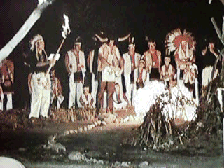 Another Stereotype of the Month entry:
Another Stereotype of the Month entry:
 Another Stereotype of the Month entry:
Another Stereotype of the Month entry:
American Indian references will live on around W.Va.'s 4-H camps
Posted: Wednesday, Jun 15, 2005 -- 08:28:30 pm EDT
By TOM BONE
The practice of invoking American Indian symbols and lore in the West Virginia 4-H camping program has survived a challenge and appears stronger than ever, after a federal ruling released this week.
For more than 75 years, boys and girls have gathered around the council fire during 4-H camp as members of one of four "tribes" and competed with each other for honors, both individual and as a group. I was one of them as a teenager in Monroe County, which is one of the birthplaces of West Virginia 4-H. I have always felt the traditions were an overall positive educational experience about the original inhabitants of our continent.
That tradition was thrown into doubt when a white Roane County resident, Wess Harris, filed a complaint in 2001 stating that the practices he witnessed were "racially stereotypical."
The 4-H program nationwide derives much of its funding from the federal Department of Agriculture. When the complaint surfaced, West Virginia's arm of 4-H was threatened with the loss of about $5 million a year, according to The Associated Press, if it were found to violate federal laws against racial discrimination.
In a final report released on Monday, the Department of Agriculture's Office of Civil Rights found no violation of the 1964 Civl Rights Act, the AP reported.
The complaint and investigation, in the final analysis, has produced a beneficial side effect -- after an initial detour into the Land of Overreaction.
Officials at the West Virginia University Extension Service, which oversees the state 4-H program, pushed the panic button in 2001 and issued a directive to drop most of the Native American traditions as soon after being notified of the impending federal investigation.
A howl went up from 4-H volunteers and alumni. I weighed in with an editorial cartoon showing WVU President David Hardesty and an Extension official standing near the 4-H council circle campfire while it burned their dummies in effigy.
The bureaucrats backed down in favor of having a slew of people study the issue.
The net result of that was a set of "voluntary" changes made by the camping program. The AP story said that children can no longer don feathered headdresses, paint faces mimicking modern society's portrayal of American Indians, conduct peace pipe ceremonies, engage in stereotypical dances or chant a cheer of "Ugh! Ugh! Ugh!"
"We researched each custom to determine its authenticity," 4-H Program Director Debbie McDonald told the AP. "If a custom was not authentic or a practice could be perceived as stereotypical of Native Americans, we discontinued using it in camps."
She added that many parts of the curriculum were "deemed appropriate."
The totem poles standing at the state 4-H camp at Jackson's Mill will remain standing. The four tribes -- Mingo, Cherokee, Delaware and Seneca -- will live on for the 12,000 or so children around the state attending one of 90 or more camps. Their chiefs will still wear simple felt headbands with pride. Counselors will continue to award spirit sticks for competitive victories.
And the statewide utterance of approval, "How How," will continue to be heard. The Associated Press quoted McDonald as stating that the phrase had been traced at least as far back as 1849.
Before being sent out to the week-long county camps, state-paid counselors were trained over recent years in which traditions were appropriate and non-stereotypical. This was reinforced by the USDA, which recommended a consistent guide to the state's camping lore and annual training.
State 4-H camping leader Richard Cutlip used to encourage his charges around the council circle to face challenges with a positive attitude.
The alterations to the state camping program bear out his oft-repeated slogan, "When life hands you a lemon -- make lemonade."
Rob's comment
Totem poles...the Mingo, Cherokee, Delaware, and Seneca (three tribes from the Northeast, one from the South, none with totem poles)...chiefs...headbands...spirit sticks (i.e., coup sticks)...the "how how" chant. Gee, I'm glad West Virginia's 4-H camps announced the elimination of all the inappropriate and stereotypical Indian references. Otherwise we might not have known.
Next time an organization feels like (mis)using Indian references, how about picking tribes from around the country and rotating them? More important, how about matching the cultural references to the specific tribes they belong to? This would be a much better approach than throwing them all into a melting pot as if all Indian cultures were the same or interchangeable.
Related links
YMCA-Indian Guides
Tipis, feather bonnets, and other Native American stereotypes
|
. . . |

|
All material © copyright its original owners, except where noted.
Original text and pictures © copyright 2007 by Robert Schmidt.
Copyrighted material is posted under the Fair Use provision of the Copyright Act,
which allows copying for nonprofit educational uses including criticism and commentary.
Comments sent to the publisher become the property of Blue Corn Comics
and may be used in other postings without permission.